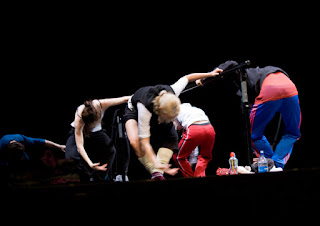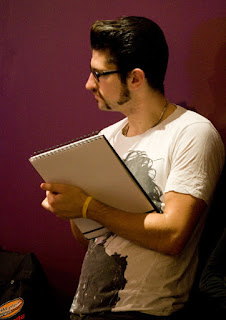Dr Sketchy's Anti-art School (
http://www.drsketchysbirmingham.co.uk/) provides an opportunity for artists (and photographers) to work with live models outside the formal environment of a traditonal Life Class. Burlesque artists perform their act, then pose for the artists. There are prizes for the best and it's very light-hearted and fun. These images were captured on 24th November 2012, when Dr Sketchy's celebrated its fourth birthday with a tribute to the films of Tim Burton.
It takes place at the The Victoria, John Bright St, Birmingham.
An old pub with lots of personality and atmosphere.
Even the Gents' is idiosyncratic; not a place to stagger down into:
The event takes place in an upper room, and naturally, there's lots of preparation to be done.
We set out the chairs while the organiser, Candee, prepares gifts for the performers.
And Pip 'Astro' Bayley arranges the furniture.
Jacob (Sound) accepts Suzie Sequin's music.
I'd arranged to record the preparations. Here is Tiffany Beau making-up as The Mad Hatter.
Of course, the inner woman needs nourishment too.
Eating is not usually a good look, but she gets away with it here.
It's a delicate operation; burlesque performers don't have the sumptuous dressing rooms of the big stars. I'm reminded of Lord Snowdon's image of Helen Mirren in
her dressing room:
http://newsimg.bbc.co.uk/media/images/44743000/jpg/_44743965_helenmirren.jpg
The Mad Hatter needs a gap between his upper incisors. It's painted on with waterproof mascara.
There: it's done. But will it come off?
The essence of Dr Sketchy's is fun.
And the final result.
It's hot, and hat and coat are discarded:
Tiffany compares notes with Liberty.
Not all the preparation is physical:
In a busy scene, where even Edward Scissorhands twiddles his 'fingers',
Kitten Von Mew remains a pillar of calm, absorbed in her role as the Corpse Bride.
Kitten stays serenely in character during the whole of her pose.
And opens her own eyes only when it's over.
The artists use different media to draw their sketches.
When the fifteen minute pose is over, Kitten judges the results.
And, with the help of the compere, singer and performer Liberty Pink, awards the prize.
Suzie Sequin plays Sally, from The Nightmare Before Christmas.
Steve Pledger plays Jack Skellington...
Also from The Nightmare Before Christmas.
And together, they pose:
For the artists:
And there's another winner:
Missy Malone as Sweeny Todd...
The shapely barber of Fleet Street:
Sandy Sure gives us Beetlejuice
And poses with his girlfriend Lydia Deetz (Frankie Lynn)
Pip wins a prize:
And looks pretty pleased about it.
The lovely Liberty Pink sings farewell...
And you couldn't have a birthday party without a cake...
by Annabel de Vetten-Peterson at Conjurer's Kitchen.
The End
Notes on Dr Sketchy’s
The Plan
It’s good to plan; there’s less
chance of missing vital things out, but one needs to be flexible, too. It’s a matter of making good
compromises. I was trying to record an
event without interrupting it. I was
asked not to move around while taking photographs, which inhibited what I
wanted to do, yet I did manage to get about a bit without disrupting the show. One of my objectives was to produce a set of pictures
for the participants, to record the event for their benefit. I’ve published the blog to the Dr Sketchy’s
people on Facebook.
Technical
It was a dull, rainy day, and I
had to use available light indoors. ISO
800, F5.6, one stop underexposure, still made it impossible to stop movement. Many of the 200 exposures I took were blurry.
The stage was intermittently lit
by coloured lights and LEDs, so white balance wasn’t simple. I’ve seen that reducing the colour temperature
in Adobe Camera RAW gives an effective exposure reduction too. I was already at a high ISO, so I didn’t want
to have to adjust exposure upwards, multiplying the noise already present. I set white balance to tungsten, but still
had to tinker with it on some shots.
With strong stage lighting, there was a big difference between darks and
lights. I tried to prevent highlights
being blown out and let the darks go to black, which helped de-clutter
backgrounds.
The Photographs
The format of the evening is that
each artiste performs her act, which usually includes removing her
clothes. While this would have provided
some interesting images, the ethos is that such photographs are not taken—or at
least, not published. The character of
the event is good-natured fun, not an erotic display. When the act is over, she resumes some of her
clothes and then poses for up to fifteen minutes for the artists and
photographers.
I’d arranged with the organiser
beforehand that I’d be able to photograph her make-up work, but on the day she was
unwell and would be unable to perform.
She asked folk to come early to help set up and we obliged. It was raining; we hurried inside; I didn’t
even take a shot of the outside of the venue.
I like my barmaid picture, which does show the character of this busy
pub, though removing the menu from the corner of the bar would have improved
it
I didn’t plan to take a picture
of the Gents’, but have always found it odd, so I included it as part of my
scene-setting. A project like this is
not about individual photographs; if they all zing then there’s no quiet place to recover. I don’t think I’ve made the setting-up shots
interesting, though.
I took several pictures of the
present-wrapping, but the close-up of the hands says more than those showing
the face of the wrapper. A couple of
days earlier I was in a portraiture workshop; if I’d followed the advice given
there I’d have had Candee holding the presents up to her face. I can’t think how that wouldn’t have looked
contrived.
I like my photographs of Tiffany
Beau more each time I see them. Given
the opportunity again, I’d make a project all about her preparation, and take
multiple shots of her completing it; putting on coat and hat, and taking them
off again when it got too hot. My pictures
of the removal of her rollers are unusable.
I could have tried to vary the shots more, but wanted to document the
process.
Post-production
I’ve tidied a few of my images,
ironed out the odd wrinkle and tightened a couple of jaw lines. This is a compromise I feel was necessary: I
want my subjects to want me to photograph them again.
I didn't try to remove the projected text from the single portrait of Jack Skellington.
What I learned, what I’ll do differently next time:
Motion blur was a problem, yet I
could have used it to produce interesting swirly images.
I took a general shot of the
empty chairs at the start, but could have taken one of the audience, later on,
which would have been more interesting.
Don’t be shy about changing lenses.
Be bolder: folk are helpful and
accommodating; I could have at least asked to take a picture in the Ladies’,
which was being used as a changing room.
After all, I took a photo in the Gents’.
Adapt; be aware of and look out
for opportunities to diversify, to follow an individual while being aware of
the group. The opportunity to do a set
exclusively on Tiffany’s evening, from make-up to relaxing afterwards, was
there, but I didn’t see it.
Summary
In my photographs I’ve tried to
tell the story of the evening, well, a
story, and I think this has been fairly successful. It has a beginning, middle, and end. I’ve included all the performers, and brought
the story back to its beginning: the fourth birthday celebration.
Mike White
30th November 2013































































